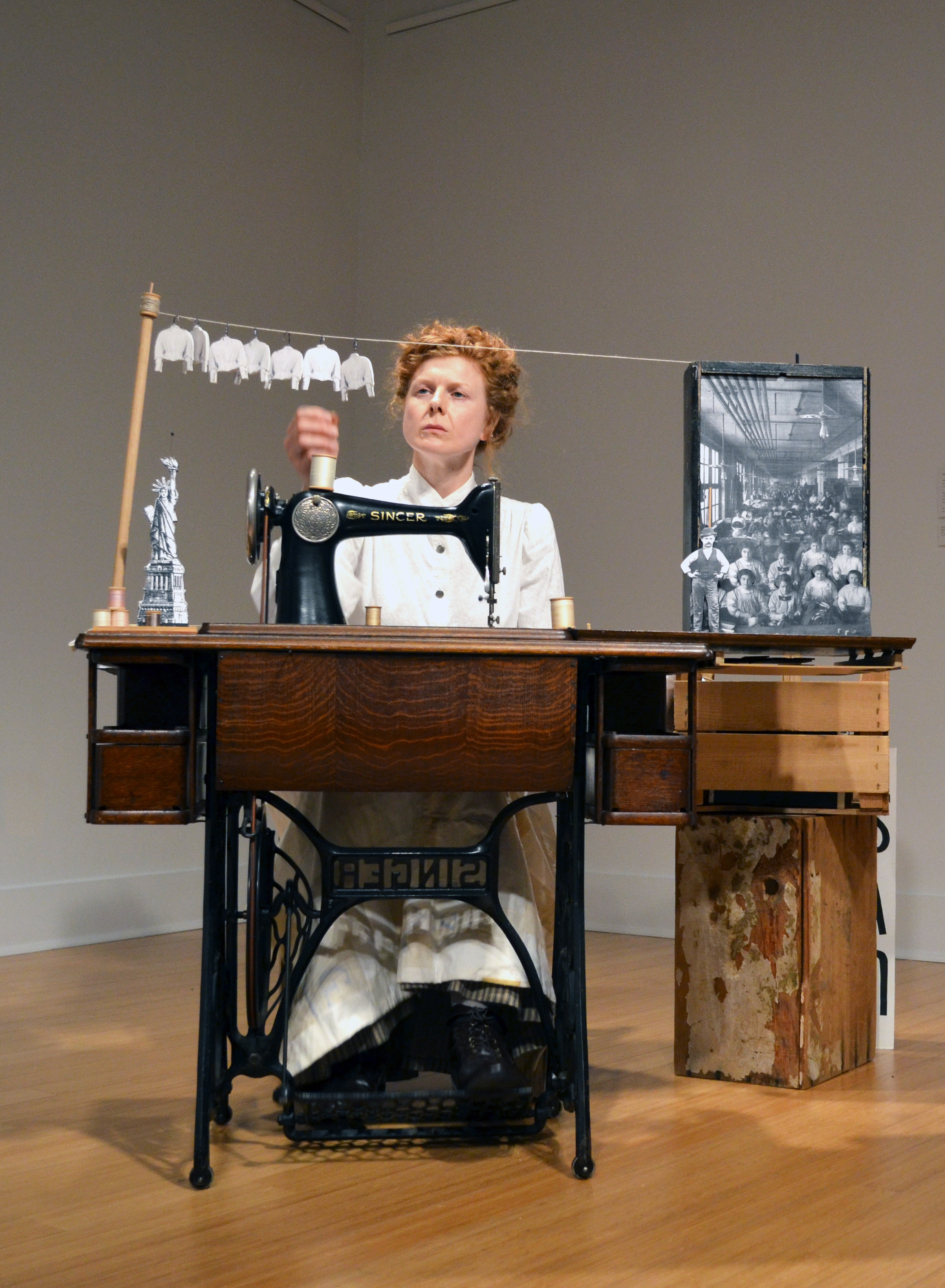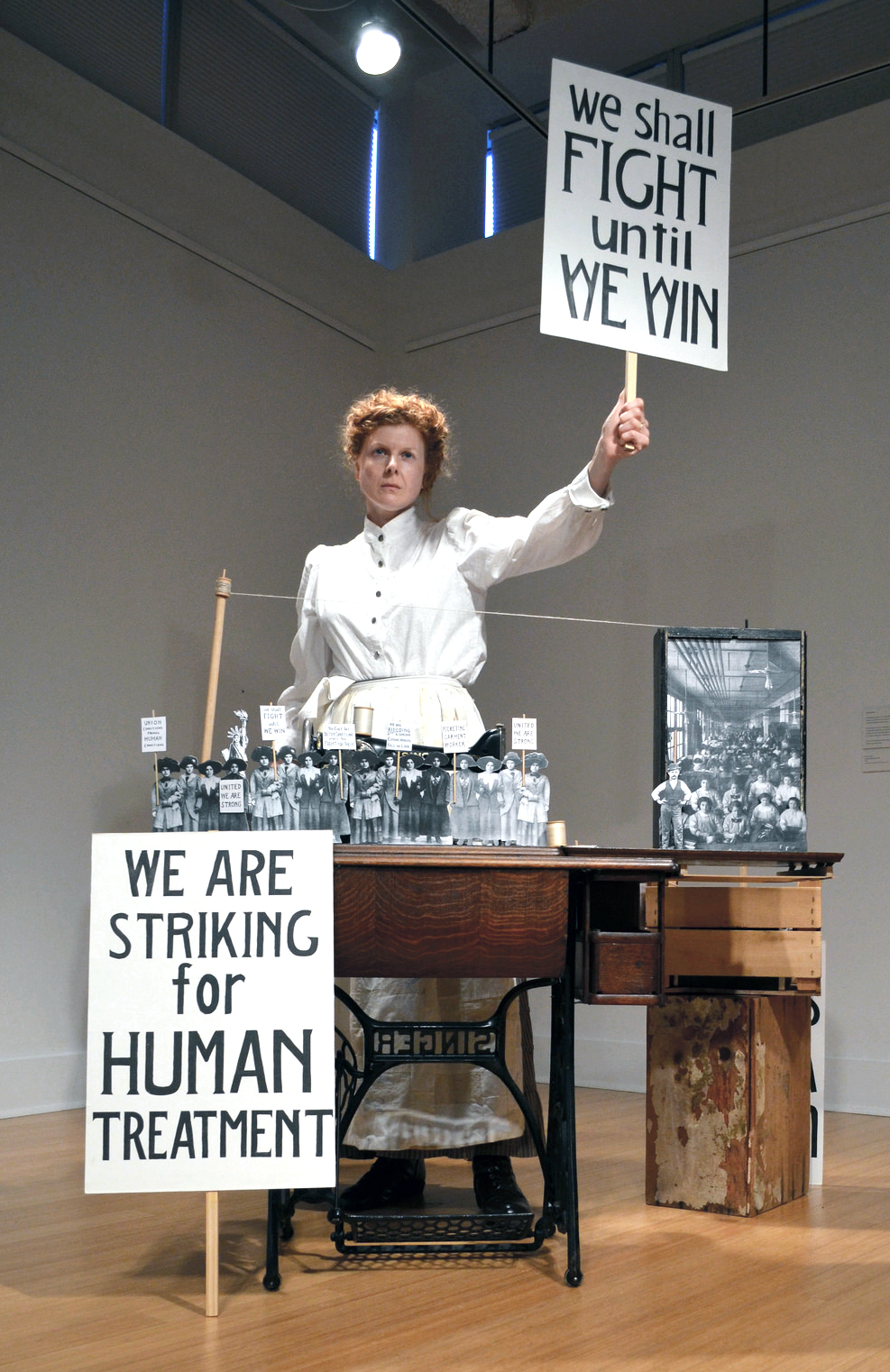About Valeska
Baltimore City

Valeska Maria Populoh works as an educator, cultural organizer, artist and performer in Baltimore. She teaches at the Maryland Institute College of Art and is an affiliated artist with Black Cherry Puppet Theater. Valeska utilizes costume, mask and puppetry techniques to create performances and actions that respond to environmental and social concerns. An interest in acts of transformation, from materials to situations, informs her work. Valeska has performed at the … more
Jump to a project:
The Garment Worker's Tale
“The Garment Worker’s Tale” follows the journey of a young immigrant who leaves her home country to seek her fortune in America. The story is inspired by historic accounts of garment workers at the end of the 19th century in Baltimore and New York City, and by events like the Triangle Shirt Waist Factory Fire. The puppets are based on archival photos of immigrants and garment workers of the time, and the buildings and on historic street scenes of Baltimore. There is no dialogue or spoken narrative. The performance is accompanied only by a real time, electronic score created and assembled by Baltimore-based composers Jonah Beram and Patrick McMinn. There is no spoken text. Musical motifs for the characters were adapted from songs written in Baltimore by immigrant composers of the period. These fragments were developed into set pieces that play through the performance. A series of audio collages provide atmospheric backing. These are crafted by a custom software that stitches together recordings of small domestic objects in real time. (approximate length: 15 minutes, appropriate for all ages.)
-
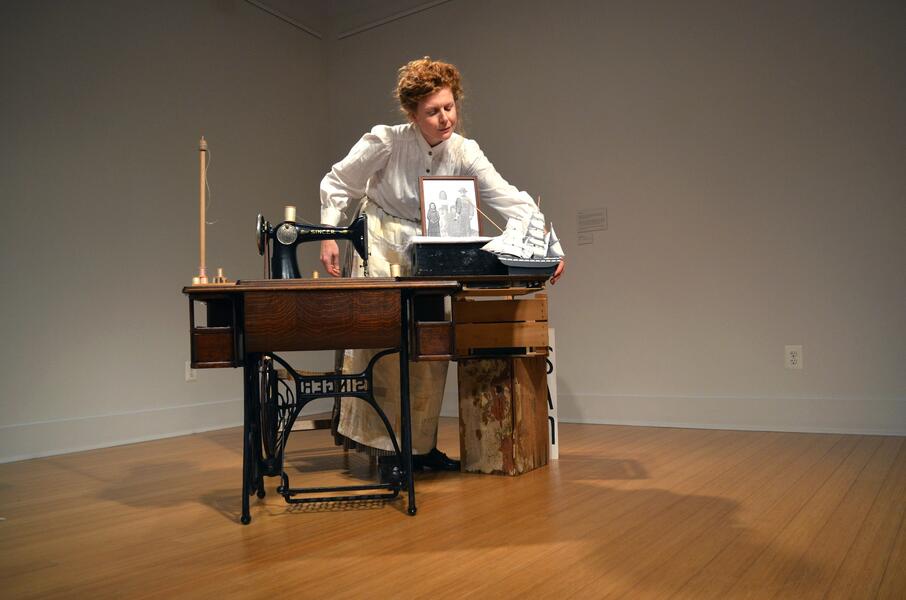 Populoh_2014_GWT_Ship.jpg“The Garment Worker’s Tale” follows the journey of a young immigrant who leaves her home country to seek her fortune in America. The story is inspired by historic accounts of garment workers at the end of the 19th century in Baltimore and New York City, and by events like the Triangle Shirt Waist Factory Fire. The puppets are based on archival photos of immigrants and garment workers of the time, and the buildings and on historic street scenes of Baltimore. There is no dialogue or spoken narrative. The performance is accompanied only by a real time, electronic score created and assembled by Baltimore-based composers Jonah Beram and Patrick McMinn. There is no spoken text. Musical motifs for the characters were adapted from songs written in Baltimore by immigrant composers of the period. These fragments were developed into set pieces that play through the performance. A series of audio collages provide atmospheric backing. These are crafted by a custom software that stitches together recordings of small domestic objects in real time. (approximate length: 15 minutes, appropriate for all ages.)
Populoh_2014_GWT_Ship.jpg“The Garment Worker’s Tale” follows the journey of a young immigrant who leaves her home country to seek her fortune in America. The story is inspired by historic accounts of garment workers at the end of the 19th century in Baltimore and New York City, and by events like the Triangle Shirt Waist Factory Fire. The puppets are based on archival photos of immigrants and garment workers of the time, and the buildings and on historic street scenes of Baltimore. There is no dialogue or spoken narrative. The performance is accompanied only by a real time, electronic score created and assembled by Baltimore-based composers Jonah Beram and Patrick McMinn. There is no spoken text. Musical motifs for the characters were adapted from songs written in Baltimore by immigrant composers of the period. These fragments were developed into set pieces that play through the performance. A series of audio collages provide atmospheric backing. These are crafted by a custom software that stitches together recordings of small domestic objects in real time. (approximate length: 15 minutes, appropriate for all ages.) -
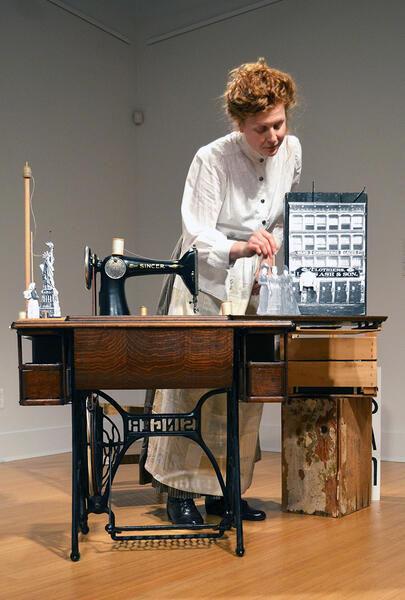 LadiesAtTheShop_GWT_Ripple_MelissaWebb_web.jpg“The Garment Worker’s Tale” follows the journey of a young immigrant who leaves her home country to seek her fortune in America. The story is inspired by historic accounts of garment workers at the end of the 19th century in Baltimore and New York City, and by events like the Triangle Shirt Waist Factory Fire. The puppets are based on archival photos of immigrants and garment workers of the time, and the buildings and on historic street scenes of Baltimore. There is no dialogue or spoken narrative. The performance is accompanied only by a real time, electronic score created and assembled by Baltimore-based composers Jonah Beram and Patrick McMinn. There is no spoken text. Musical motifs for the characters were adapted from songs written in Baltimore by immigrant composers of the period. These fragments were developed into set pieces that play through the performance. A series of audio collages provide atmospheric backing. These are crafted by a custom software that stitches together recordings of small domestic objects in real time. (approximate length: 15 minutes, appropriate for all ages.)
LadiesAtTheShop_GWT_Ripple_MelissaWebb_web.jpg“The Garment Worker’s Tale” follows the journey of a young immigrant who leaves her home country to seek her fortune in America. The story is inspired by historic accounts of garment workers at the end of the 19th century in Baltimore and New York City, and by events like the Triangle Shirt Waist Factory Fire. The puppets are based on archival photos of immigrants and garment workers of the time, and the buildings and on historic street scenes of Baltimore. There is no dialogue or spoken narrative. The performance is accompanied only by a real time, electronic score created and assembled by Baltimore-based composers Jonah Beram and Patrick McMinn. There is no spoken text. Musical motifs for the characters were adapted from songs written in Baltimore by immigrant composers of the period. These fragments were developed into set pieces that play through the performance. A series of audio collages provide atmospheric backing. These are crafted by a custom software that stitches together recordings of small domestic objects in real time. (approximate length: 15 minutes, appropriate for all ages.) -
 Sewing_Shirtwaists.jpg“The Garment Worker’s Tale” follows the journey of a young immigrant who leaves her home country to seek her fortune in America. The story is inspired by historic accounts of garment workers at the end of the 19th century in Baltimore and New York City, and by events like the Triangle Shirt Waist Factory Fire. The puppets are based on archival photos of immigrants and garment workers of the time, and the buildings and on historic street scenes of Baltimore. There is no dialogue or spoken narrative. The performance is accompanied only by a real time, electronic score created and assembled by Baltimore-based composers Jonah Beram and Patrick McMinn. There is no spoken text. Musical motifs for the characters were adapted from songs written in Baltimore by immigrant composers of the period. These fragments were developed into set pieces that play through the performance. A series of audio collages provide atmospheric backing. These are crafted by a custom software that stitches together recordings of small domestic objects in real time. (approximate length: 15 minutes, appropriate for all ages.)
Sewing_Shirtwaists.jpg“The Garment Worker’s Tale” follows the journey of a young immigrant who leaves her home country to seek her fortune in America. The story is inspired by historic accounts of garment workers at the end of the 19th century in Baltimore and New York City, and by events like the Triangle Shirt Waist Factory Fire. The puppets are based on archival photos of immigrants and garment workers of the time, and the buildings and on historic street scenes of Baltimore. There is no dialogue or spoken narrative. The performance is accompanied only by a real time, electronic score created and assembled by Baltimore-based composers Jonah Beram and Patrick McMinn. There is no spoken text. Musical motifs for the characters were adapted from songs written in Baltimore by immigrant composers of the period. These fragments were developed into set pieces that play through the performance. A series of audio collages provide atmospheric backing. These are crafted by a custom software that stitches together recordings of small domestic objects in real time. (approximate length: 15 minutes, appropriate for all ages.) -
 Populoh_GarmentWorkersTale_2014_Strike_creditMelissaWebb.jpg“The Garment Worker’s Tale” follows the journey of a young immigrant who leaves her home country to seek her fortune in America. The story is inspired by historic accounts of garment workers at the end of the 19th century in Baltimore and New York City, and by events like the Triangle Shirt Waist Factory Fire. The puppets are based on archival photos of immigrants and garment workers of the time, and the buildings and on historic street scenes of Baltimore. There is no dialogue or spoken narrative. The performance is accompanied only by a real time, electronic score created and assembled by Baltimore-based composers Jonah Beram and Patrick McMinn. There is no spoken text. Musical motifs for the characters were adapted from songs written in Baltimore by immigrant composers of the period. These fragments were developed into set pieces that play through the performance. A series of audio collages provide atmospheric backing. These are crafted by a custom software that stitches together recordings of small domestic objects in real time. (approximate length: 15 minutes, appropriate for all ages.)
Populoh_GarmentWorkersTale_2014_Strike_creditMelissaWebb.jpg“The Garment Worker’s Tale” follows the journey of a young immigrant who leaves her home country to seek her fortune in America. The story is inspired by historic accounts of garment workers at the end of the 19th century in Baltimore and New York City, and by events like the Triangle Shirt Waist Factory Fire. The puppets are based on archival photos of immigrants and garment workers of the time, and the buildings and on historic street scenes of Baltimore. There is no dialogue or spoken narrative. The performance is accompanied only by a real time, electronic score created and assembled by Baltimore-based composers Jonah Beram and Patrick McMinn. There is no spoken text. Musical motifs for the characters were adapted from songs written in Baltimore by immigrant composers of the period. These fragments were developed into set pieces that play through the performance. A series of audio collages provide atmospheric backing. These are crafted by a custom software that stitches together recordings of small domestic objects in real time. (approximate length: 15 minutes, appropriate for all ages.) -
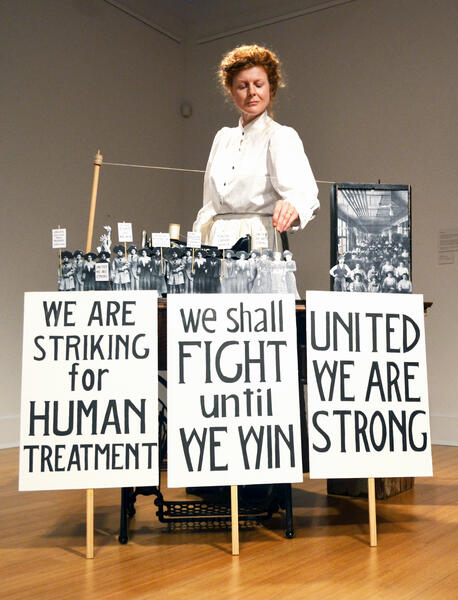 WeAreStriking.jpg“The Garment Worker’s Tale” follows the journey of a young immigrant who leaves her home country to seek her fortune in America. The story is inspired by historic accounts of garment workers at the end of the 19th century in Baltimore and New York City, and by events like the Triangle Shirt Waist Factory Fire. The puppets are based on archival photos of immigrants and garment workers of the time, and the buildings and on historic street scenes of Baltimore. There is no dialogue or spoken narrative. The performance is accompanied only by a real time, electronic score created and assembled by Baltimore-based composers Jonah Beram and Patrick McMinn. There is no spoken text. Musical motifs for the characters were adapted from songs written in Baltimore by immigrant composers of the period. These fragments were developed into set pieces that play through the performance. A series of audio collages provide atmospheric backing. These are crafted by a custom software that stitches together recordings of small domestic objects in real time. (approximate length: 15 minutes, appropriate for all ages.)
WeAreStriking.jpg“The Garment Worker’s Tale” follows the journey of a young immigrant who leaves her home country to seek her fortune in America. The story is inspired by historic accounts of garment workers at the end of the 19th century in Baltimore and New York City, and by events like the Triangle Shirt Waist Factory Fire. The puppets are based on archival photos of immigrants and garment workers of the time, and the buildings and on historic street scenes of Baltimore. There is no dialogue or spoken narrative. The performance is accompanied only by a real time, electronic score created and assembled by Baltimore-based composers Jonah Beram and Patrick McMinn. There is no spoken text. Musical motifs for the characters were adapted from songs written in Baltimore by immigrant composers of the period. These fragments were developed into set pieces that play through the performance. A series of audio collages provide atmospheric backing. These are crafted by a custom software that stitches together recordings of small domestic objects in real time. (approximate length: 15 minutes, appropriate for all ages.)


